
About UsThe Numismatic Bibliomania Society is a non-profit organization promoting numismatic literature. For more information please see our web site at coinbooks.org SubscriptionsThose wishing to become new E-Sylum subscribers (or wishing to Unsubscribe) can go to the following web page link MembershipThere is a membership application available on the web site Membership Application To join, print the application and return it with your check to the address printed on the application. Membership is only $15 to addresses in the U.S., $20 for First Class mail, and $25 elsewhere. For those without web access, write to: David M. Sundman, Secretary/TreasurerNumismatic Bibliomania
Society AsylumFor Asylum mailing address changes and other membership questions, contact David at this email address: dsundman@LittletonCoin.com SubmissionsTo submit items for publication in The E-Sylum, just Reply to this message, or write to the Editor at this address: whomren@coinlibrary.com
BUY THE BOOK BEFORE THE COINYou won't regret it! |
- WAYNE'S WORDS: THE E-SYLUM JANUARY 29, 2012
- SKLOW MAIL BID SALE #15 CLOSES FEBRUARY 11, 2009
- KOLBE & FANNING'S 124TH MAIL-BID SALE CLOSES FEBRUARY 23, 2012
- NEW BOOK: THE GUIDE BOOK OF CANADIAN COINS AND TOKENS
- NEW BOOK: ROCHESTER NUMISMATIC ASSOCIATION CENTENNIAL HISTORY
- LECTURE: HISTORIANS AND NUMISMATISTS AND ROMAN COINS
- HOLY COW - THAT LOOKS LIKE A BULL!
- ON COLORING COINS AND MEDALS
- SPINTRIAE ARE NO BROTHEL TOKENS
- NOTES FROM E-SYLUM READERS: JANUARY 29, 2012
- QUERY: HOW LONG DOES PERMISSION TO REPRINT LAST?
- QUERY: ISSUES OF 'THE NUMISMATIC JOURNAL'
- QUERY: CAL WILSON'S NUMISMATIC REPOSITORY
- QUERY: SWEDISH MINT MUSEUM 1815 HALF EAGLE
- QUERY: CIVIL WAR SCRIP TRAIN VIGNETTE USAGE SOUGHT
- QUERY: PEDIGREE OF THE DECADRACHM OF AKRAGAS
- MORE ON MEDAL MAKER LORIOLI FRATELLI
- HARVEY STACK: THOUGHTS OF AN OLDTIME AUCTIONEER
- THE QUOIN CLUB
- CHICAGO NEWSPAPER ARTICLE HIGHLIGHTS HARLAN BERK
- THE NEW ORLEANS MINT TREASURE
- DEALERS REBEL OVER ROYAL MINT'S COMMEMORATIVE FLOOD
- ZAMBIA TO REVALUE CURRENCY AND INTRODUCE COINS
- BANKNOTE MATH QUESTIONED
- RUSSIAN LOCAL CURRENCIES OF THE 1990S
- COIN SHORTAGE IN INDIA PROMPTS SPURS PRIVATE MINTERS
- MEDIEVAL COIN HOARD FOUND IN 1926 GOES ON DISPLAY
- FEATURED WEB SITE: ROCHESTER NUMISMATIC ASSOCIATION
WAYNE'S WORDS: THE E-SYLUM JANUARY 29, 2012

New subscribers this week include Todd Pollock and Carlos Posadas. Welcome aboard! We have 1,506 email subscribers, plus 170 followers on Facebook.
This week we open with information on two upcoming numismatic literature sales, two new books and a lecture relating to numismatic literature. Other topics this week include several reader queries on topics from Civil War scrip vignettes to Cal Wilson's Numismatic repository.
You know, I honestly never know which E-Sylum item is going to draw a good response from readers. I've long since given up predicting. But E-Sylum readers can always be counted on to provide the most interesting and authoritative information on any topic under the sun. Be sure to read Dick Johnson's submission, a fabulous summary of coloring on coins and medals, and Ursula Kampmann's notes on Roman "brothel tokens".
To learn more about spintriae, enamelling, pad printing, 1990s Russian scrip, Colonial Jack's Long Walk, the Decadrachm of Akragas and how to tell a cow from a bull, read on. Have a great week, everyone!
Wayne Homren
(whomren@gmail.com)
Numismatic Bibliomania Society
SKLOW MAIL BID SALE #15 CLOSES FEBRUARY 11, 2009
 David Sklow-Fine Numismatic Books - Mail Bid Sale # 15 Closes Saturday February 11th at 8pm MT.
Bids are accepted via - Email - Fax - Telephone - U.S. Mail
David Sklow-Fine Numismatic Books - Mail Bid Sale # 15 Closes Saturday February 11th at 8pm MT.
Bids are accepted via - Email - Fax - Telephone - U.S. Mail
Be sure to submit your bids in the most diverse sale we have ever held. There is something for everyone, collectors, researchers and bibliophiles! So look close and find your treasure!
Here are some of the highlights, a complete catalog is available on our web site and in print form by mail.
- Handbook of U.S. Coins, by Yeoman, Hewitt and Green, several first editions 1942
- Handbook of U. S. Coins, by Yeoman, Hewitt and Green, editions 2nd through 13th including over date/overprint fourth and ninth editions.
- Rarely seen autographed fifth edition Handbook of U.S. Coins, signed by Author Charles E. Green.
- 1908 first Membership Directory of the American Numismatic Association.
- 1913 second Membership Directory of the American Numismatic Association.
- 1917 third Membership Directory of the American Numismatic Association.
- Unique 1883 edition of Andrews, used and annotated by B. Max Mehl as a mockup for his 1924 reprint of the work.
- Ken Lowes deluxe hardbound 100th anniversary edition of Rare Coin Review Copy No. 23.
- Armand Champa's Numismatica Americana 1991 deluxe leather version, ex: Denis Mendelson.
- Unique prototype full green leather bound mockup by Alan Grace [1985] to exhibit his binding techniques to Champa.
- Frossard thirty-seventh sale Oct 1884, thick paper, plated.
- Frossard Monograph on 1793-1857 Cents & Half Cents, 1879, 9 plates.
- Frossard, Numisma 1983 reprint super deluxe half leather limited numbered edition No. 3 of 4.
- Gengerke's American Numismatic Auctions 1990 eighth edition super deluxe half leather limited numbered edition No. 3 of 6.
- Unique prototype hardbound textured green cloth black mockup for Gengerke's eighth edition.
- Rare three volume set of bound auction catalogs one thru ten of The Money Tree limited numbered editions No. 1 of 7.
- Scott & Co. 40th sale catalog March 1882, plated.
- Smith, A. M. Coin Collectors of the U. S. Illustrated Guide, Volume one complete 1880-1881.
- Smith, Pete American Numismatic Biographies 1992, half leather super deluxe limited numbered edition No. 3 of 4.
- 1946 Davenport, Iowa Rare three piece convention medal set of the American Numismatic Association, Bronze, Silver & Gold medals in original box.
- 1975 Los Angeles, Ca. Rare American Numismatic Association convention medal in gold, limited numbered 74 of 161.
- 1976 New York, N.Y. Very Rare American Numismatic Association convention medal in gold, limited numbered 24 of 41.
- 1987 scarce Casa de Moneda de Mexico and American Numismatic Association 63mm five ounce silver medal.
- Unique mockup [by Fivaz & Stanton] working copy of the Cherrypickers guide second edition used to create the third edition.
- Run of Official ANA Convention medal sets all in original holders or boxes 1969 to 1992, 1996-1999.
- Never offered for sale before, the newly awarded ANA Presidential Award Medal 76mm. inscribed to Rollie Finner.
- The fabulous working library concerning Medals & Tokens of Russ Sears, containing many limited editions.
- A long run of Yeoman's Red Book 1947-2002, including many special editions.
- An enormous working library, both U. S. & world of a dedicated dealer, some very nice surprises!
- Convention and Banquet photographs of the American Numismatic Association, 1924, 1947, 1948, 1953, 1954, 1958, 1971.
- Dr. Josef Brettauer, Medicina in Nummis 1937 catalog.
- Keith Davignon, Contemporary Counterfeit Capped Bust Half Dollars, full leather super deluxe presentation limited numbered edition No. 5 of 5.
- Elder May 1920 sale of the Miller Collection, Rosa Americana's 1992 reprint with 28 plates produced from full size negatives, bound limited numbered edition No. 23 of 50.
- Fey & Oxman's The Top Morgan Dollar Varieties: The VAM Keys, full leather super deluxe limited numbered edition No. 50 of 100.
- R. W. Julian, Russian Silver Coinage 1796-1917, quarter leather super deluxe limited numbered edition No. 2 of 24.
- Glenn R. Peterson, The Ultimate Guide to Attributing Bust Half Dollars, quarter leather super deluxe limited numbered edition No. 3 of 40.
- Nice run of Pine Tree Auction catalogs
- Nicolas Tindal, 1751 A Summary of Mr. Rapin de Thoyras's History of England, [elephant folio].
Bidders may enter bids by mail, telephone, email or fax. The sale closes at 8pm mountain time, Saturday February 11, 2012, however, any bids left on our answering machines or sent by email or fax on or before midnight on closing day will be accepted.
David Sklow-Fine Numismatic Books
P.O. Box 6321
Colorado Springs, CO 80934
PH: 719-302-5686
FAX: 719-302-4933
EMAIL: numismaticbooks@aol.com
WEB: FineNumismaticBooks.com
KOLBE & FANNING'S 124TH MAIL-BID SALE CLOSES FEBRUARY 23, 2012
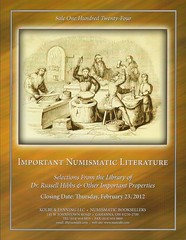 Kolbe & Fanning Numismatic Booksellers are pleased to announce their upcoming 124th mail-bid, telephone and email sale, closing on February 23, 2012. Due to a printer's overrun we are pleased to offer copies of the catalogue, while supplies last, at only $5.00 per copy, which scarcely begins to cover the costs of printing and postage.
Kolbe & Fanning Numismatic Booksellers are pleased to announce their upcoming 124th mail-bid, telephone and email sale, closing on February 23, 2012. Due to a printer's overrun we are pleased to offer copies of the catalogue, while supplies last, at only $5.00 per copy, which scarcely begins to cover the costs of printing and postage.
The 8.5 by 11 inch catalogue comprises 104 pages, in which 1225 lots of rare and desirable numismatic publications are described in depth, generally accompanied by interesting and informative footnotes. Order a copy of the catalogue today by sending $5.00 to KOLBE & FANNING NUMISMATIC BOOKSELLERS LLC, 141 W JOHNSTOWN ROAD, GAHANNA OH 43230-2700. Money back if you are not satisfied. The catalogue is also accessible free of charge on the Kolbe & Fanning website at www.numislit.com.
The sale features a wide-ranging selection of interesting and elusive works on ancient, medieval and modern numismatics, as well as a goodly number of classic works on American numismatic topics.
The sale starts off with selections from the library of Dr. Russell Hibbs, which covers the numismatic spectrum. It is followed by over two dozen additional interesting consignments.
Sale highlights include:
- A complete set of American Numismatic Society Museum Notes
- The only auction sale catalogue issued by Virgil Brand's Chicago Coin Co., dated April 29, 1910, considered by Q. David Bowers to be "one of the scarcest pieces of numismatic ephemera from the era"
- A complete set of Yeoman's Guide Book of United States Coin, popularly known as The Red Book
- Books and elusive periodicals on Australian numismatics
- A 1929-1950 edition of Browning's Early Quarter Dollars with photographic plates
- Extremely rare illustrated publications by Charles Clay on Isle of Man coinage
- The first 50 volumes of the Colonial Newsletter
- A fine set of The Asylum
- Pridmore's rare 1974 work on the coins and paper money of Cyprus
- An original 1883 Newlin on half dimes, with photographic plates
- A complete set of The Numismatic and Philatelic Journal of Japan
- The Ray Byrne photographic archives, comprising thousands of prints on Latin American and West Indies coins and tokens
- An interesting selection of United States newspapers with numismatic content, dating from 1792 to 1892
- An extensive run of Stack's Fixed Price Lists, dating from 1939 to 1997
- A reprint set of Babelon's Traité des Monnaies Grecques et Romaines.
Consignments are currently being accepted for Kolbe & Fanning's June 7th and October 4th, 2012 sales and it is not too soon to consider consigning outstanding works to the January 2013 New York Book Sale, the firm's annual marquee public auction held at the Waldorf Astoria Hotel in conjunction with the New York International Numismatic Convention. Contact details are provided at www.numislit.com or interested parties may call (614) 414-0855.
NEW BOOK: THE GUIDE BOOK OF CANADIAN COINS AND TOKENS
 Whitman Publishing has released the first edition of a brand-new work on Canadian numismatics. The Guide Book of Canadian Coins and Tokens, by Dr. James A. Haxby, is available now from booksellers and hobby shops, and online including at Whitman.com. The 464-page hardcover book is illustrated with more than 1,600 full-color photographs. It retails for $19.95 in the United States ($22.95 in Canada).
Whitman Publishing has released the first edition of a brand-new work on Canadian numismatics. The Guide Book of Canadian Coins and Tokens, by Dr. James A. Haxby, is available now from booksellers and hobby shops, and online including at Whitman.com. The 464-page hardcover book is illustrated with more than 1,600 full-color photographs. It retails for $19.95 in the United States ($22.95 in Canada).
The Guide Book of Canadian Coins and Tokens is an illustrated price guide, history, and reference book on provincial and colonial Canadian issues and coinage of the Dominion of Canada, ranging from the 1500s to the present day.
Educational features include a history of early money among the First Nations, in Nouvelle France, and in British North America; a study of the manufacture of coinage dies; information on mints, mintmarks, privy marks, test marks, composition marks, and mintage figures; a glossary of numismatic terms; essays on toning, third-party grading, authenticity, and other hobby topics; sections on hobby organizations and periodicals; and essays on the British monarchy as related to Canadian numismatics.
Collector information includes studies of Victorian coin die varieties; detailed grading instructions; a history of each coin type; technical specifications for each; more than 1,600 full-color photographs and enlargements; mintages; and retail values in up to 12 grades (including circulation strikes, plus Specimen coins, Proofs, Brilliant Uncirculated, and other special-finish formats).
The Guide Book of Canadian Coins and Tokens covers all of the Canadian colonies and provinces, as well as modern (1867 to date) coinage of the Dominion of Canada. It includes bullion coins, popular die varieties, commemoratives, misstruck coins and mint errors, coin sets, patterns, and test tokens.
The 140-page section on early Canadian coins and tokens includes extensive full-color coverage of French regime coinage, fur trade tokens, Nova Scotia, Magdalen Island, New Brunswick, Prince Edward Island, Newfoundland, Lower Canada, Upper Canada, the Province of Canada, and British colonial items (including special-use tokens, various bank tokens, concoctions made for collectors, borderline and questionable tokens, and others).
The new book's layout and informational design are patterned after Whitman's popular Guide Book of United States Coins, known to collectors as the "Red Book." It includes Canadian versions of Red Book staples including bullion-value charts for silver and gold coins, and a list of the top 250 Canadian coin prices realized at auction. A detailed table of contents and a full index make it easy to find content within the book.
Award-winning researcher James Haxby is well known in the numismatic community. He pioneered the modern study of Canadian coins in the early 1970s with Western Publishing, then the parent company of Whitman's coin guides. Haxby has been active in Canadian numismatics since, and the new Guide Book of Canadian Coins and Tokens marks his return as a Whitman author.
A Guide Book of Canadian Coins and Tokens - James A. Haxby - 464 pages - Hardcover - Full color - $19.95 U.S. ($22.95 Canada) - ISBN 0794822517
For more information, or to order, see: whitman.com/Inventory/Detail/Guide-Book-of-Canadian-Coins
NEW BOOK: ROCHESTER NUMISMATIC ASSOCIATION CENTENNIAL HISTORY
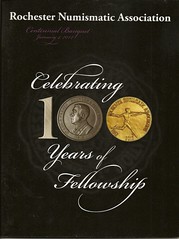 Nick Graver forwarded me a copy of the new centennial history of the Rochester Numismatic Association. Written by RNA member and past president Scott Fybush, it is titled "Celebrating 100 Years of Numismatic Fellowship". The 38-page staple-bound softcover measures 8 1/2" x 11" and is printed in color on glossy magazine stock. 300 copies were printed. The price is $10.00 postpaid, available from:
RNA History, PO Box 10056, Rochester, NY 14610.
Nick Graver forwarded me a copy of the new centennial history of the Rochester Numismatic Association. Written by RNA member and past president Scott Fybush, it is titled "Celebrating 100 Years of Numismatic Fellowship". The 38-page staple-bound softcover measures 8 1/2" x 11" and is printed in color on glossy magazine stock. 300 copies were printed. The price is $10.00 postpaid, available from:
RNA History, PO Box 10056, Rochester, NY 14610.
It's a nicely done and well produced work, with many images of club members, medals and memorabilia. Sections include:
- In the Beginning: 1912
- 1913-1927: Boom years
- 1928-1941: Surviving the Depression
- 1941-1946: The RNA Goes to War
- 1947-1961: Peace, Prosperity and Youth
- 1962-1978: Years of Growth And Stability
- 1979-1996: New Coins, New Medals, New Awards, New Locations
- 1997-2012: Into the Future
I've always felt that a numismatic library lacking club histories such as this one are inadequate. The story of numismatics in this country is inextricably intertwined with the history of its numismatists and the organizations they founded and attended. So fork out the ten bucks, people! This is a delightful history of a great club, filled with lots of interesting anecdotes.
QUICK QUIZ: Name just a few of the many nationally-known numismatists who have called the Rochester Numismatic Association their home club. EXTRA CREDIT: Tell us an interesting story about one of them.
LECTURE: HISTORIANS AND NUMISMATISTS AND ROMAN COINS
Regarding an upcoming lecture by Terry Belanger, Founder of Rare Book School, University of Virginia, George Kolbe writes:
There is an expanded description of the lecture at: www.c1718cs.ucla.edu/calendar.htm . I thought Big E readers might like a reminder.
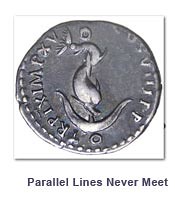 In 1501, the celebrated Venetian scholar-publisher Aldus Manutius first used the motif of a dolphin wrapped around an anchor as his firm's device or logo, and he subsequently employed it many times on title pages and colophons - as did a variety of piratical imitators, publishers who also appropriated Aldus's handsome italic typefaces and convenient octavo formats. The dolphin-and-anchor motif was later adopted by William Pickering in nineteenth-century London and Nelson Doubleday in twentieth-century New York, and it remains perhaps the best known of all publishers' devices.
In 1501, the celebrated Venetian scholar-publisher Aldus Manutius first used the motif of a dolphin wrapped around an anchor as his firm's device or logo, and he subsequently employed it many times on title pages and colophons - as did a variety of piratical imitators, publishers who also appropriated Aldus's handsome italic typefaces and convenient octavo formats. The dolphin-and-anchor motif was later adopted by William Pickering in nineteenth-century London and Nelson Doubleday in twentieth-century New York, and it remains perhaps the best known of all publishers' devices.
Erasmus tells us that Aldus derived the anchor-and-dolphin image from a first-century AD Roman silver coin, incorrectly attributing it to the reign of the Emperor Vespasian. In fact, the anchor-and-dolphin device was used only on silver denarii successively issued by Vespasian's two sons, the Emperors Titus (79 - 81) and Domitian (81 - 96). Following Erasmus, historians of the book have ever since consistently misattributed the anchor-and-dolphin denarius, which they tend to exalt as one of the most celebrated of all ancient coins, comparable in importance to the 30 pieces of silver and the widow's mite.
Numismatists take a different view: the coin has never been of much interest to students of Imperial Roman coins, who almost never mention the Aldine connection.
Terry Belanger's illustrated lecture, accompanied by a three-dimensional handout, is a case study in the way that different scholarly disciplines can sometimes fail to recognize the utility of evidence easily available from fields outside their own immediate areas of interest.

HOLY COW - THAT LOOKS LIKE A BULL!
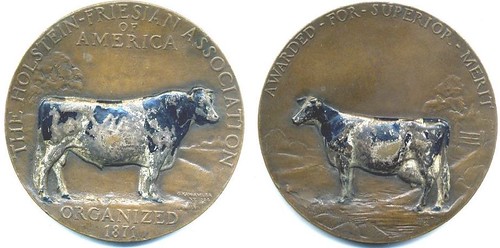
Jim Duncan of New Zealand writes:
Is not the cow in the left hand medal a male cow - to wit a BULL? The other one on the right is certainly a female bull - a cow. Nice medal though.
David Klinger writes:
I'm no farmer, but the COW MEDAL you featured last week seems to have a BULL on the obverse, and a COW on the reverse.
But, I do think the two-cow mistake was udderly understandable. I also agree that this design presents a good use of enameling.
To read the earlier E-Sylum article, see: GOZO KAWAMURA, COW MEDALLIST (www.coinbooks.org/esylum_v15n04a16.html)
ON COLORING COINS AND MEDALS
For the first 900 years coins were monochrome -- one color! -- the color of bronze, silver, or gold. It was Max Schwab who began selling equipment to mints and jewelers in 1550 that allowed jewelers to strike their creations. They could have a pin, say, struck in metal with Maxz Schwab's equipment and then add color. But this didn't happen to coins or medals.
It was jewelers who applied an ancient technique of melting colored glass to give color to their metal jewelry. They learned they could break the glass into tiny pieces, lay this in a cavity in a metal item and fire it -- place it in an oven whose temperature would melt the glass but would not melt the metal. [Glass melts 750 to 850 degree Centigrade; copper, for example, melts at 1085 degrees C).
In time, Jewelers applied this technique to decorations and the elaborate regalia worn by royalty. Really good jewelers became Royal Jewelers and these are the ones who made decorations in elaborate design, with skilled techniques, and color in the pendant medals, ribbons and sashes.
Their technique in making decorations and orders in color was preparing glass in solid pure colors by grinding to a power form. The metal base had either a cavity or a fence -- called a casson -- in which they poured the powdered glass. When fired the glass melted, flowed and solidified within the confine of that intended area. This was the process of enameling.
Enamel provided vibrant colors, a smooth, hard surface (but it could chip), and last as long as the metal base. It was ideal for decorations but it was not ideal for coinage. Thus coins remained monochrome for so many centuries.
The first attempts to color a coin was a plug of a different colored medal. This followed, only recently, by ring technology of blanks of two, then three rings of contrasting color.
The end of the 20th century brought an explosion of colorizing coins and medals. Let me count the ways:
1) Contrasting metal in the blank (plug or ring).
2) Plating -- a coin or medal is masked off for the area NOT to be plated before it is inserted in a an plating tank for deposition of a contrasting color metal; the masking material is removed afterwards to exhibit the two metal surfaces.
3) Organic coating -- paint -- unsatisfactory because paint on coins and medal easily chips off, becoming unsightly. (But a medal was so treated in the 20th century, the Fairmount Park Art Association Medal of 1937 in Philadelphia was painted black.)
4) Enamel -- and there are several kinds of enamel.-- hard and soft, both with and without those fences mentioned above. They have a lot of French names: Cloisonné (that has the fences or wires to form a cell), champlevé (like Limoges enamel), grisaille (a type of painted on enamel), plique-a-jour (a transparent or translucent enamel), and others.
5) Embedments -- an item in contrasting color is embedded on the surface of a coin or medal, holograms fit in this category.
6) Pad printing -- a somewhat new technology of "printing" one or more colors on the modulated surface of a coin or medal. The ink is applied to a pad which imparts that ink to the metal surface.
7) Stickers -- Paper stickers printed in color are pasted on to a coin or medal -- "Elvis Presley coins" are made by this process.
This discussion was brought to mind by the Holstein-Cow Medal by Gozo Kawamura illustrated in last week's E-Sylum. Despite the fact this medal was made by Medallic Art Company and I cataloged it for the company while I was first employed by the firm, I cannot say for certain how the colors were applied.
It is NOT cloisonné enamel. Particularly because it does not have the fences and is enameled on both sides. If you fired a second side the enamel on the first side would melt and flow off. Such a technology, however, has been developed. It is called "Counter enameling" and it has been practiced with great skill by the Paris Mint which has issued two-sided cloisonné medals.
On the cow medal it could possibly be the white or silver color is some form of plique-a-jour and the black a grisaille. I have defined and written 1,840 technical terms in the coin and medal field for an Encyclopedia of such numismatic terms. I have 12 yet to write. Enamel and Enameling is one of those.
To read the earlier E-Sylum article, see: GOZO KAWAMURA, COW MEDALLIST (www.coinbooks.org/esylum_v15n04a16.html)
SPINTRIAE ARE NO BROTHEL TOKENS
Regarding the recent publicity around the discovery in London of what was dubbed a brothel token, Ursula Kampmann, editor of Coins Weekly writes:
Just one remark, because I have been trying to overcome this 19th century opinion for years and years and years. Spintriae are no brothel tokens. This was notion was invented in a time everything was dirt when it was connected with the sexual interaction between woman and man.
Here you will find an article on a much more probable purpose. It is certainly not my research which has revealed this background, but a great article by Ted Buttrey, which unfortunately is only scholarly and not as sexy as calling these things brothel tokens again and again and again.
Thank you once again for your brilliant newsletter, which is always very inspiring. It's incredible how fast you receive all this information. You have to be proud of your readership informing you on all these issues.
Spintriae are highly popular and expensive collectibles, but what purpose did they actually serve in Antiquity?
One has to pay high prices indeed for the so-called spintriae - brothel tokens as one is secretly whispered to. There are experts who know exactly what the function of these objects was: they were bought at the brothel's entrance. The representations had to be regarded as a kind of catalogue of pleasures on offer in that particular brothel. After choosing a position one went into the chamber whose number the token's reverse stated and the beauties - which mostly came from exotic countries - were instantly informed about their customers' desire.
Today, the spintriae have become treasured collectibles. The slightly indecent, crackerbarrel-like odour still sticks to them, to these small works of art which exercise no restraint whatsoever in showing the sexual act.
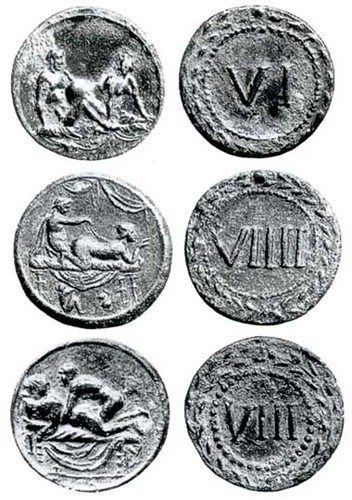
The first person that associated the spintriae with sex was a numismatist called Spanheim who published a treatise on numismatics in 1664. He invented the term "spintriae" for the small bronze pieces that surely were called different in Antiquity. He took it from Tacitus' Annals which describe the reign of Tiberius; that emperor, which - if we are inclined to follow Suetonius and Robert Ranke Graves, I, Claudius - erotic excesses are alleged to until the present day.
Spanheim's imagination was exalted when he read a remark from Tacitus (VI, 1) where the old man's erotic degenerations were described: - "And now were coined the names, hitherto unknown, of sellarii and spintriae, one drawn from the obscenity of a place, one from the versatility of the pathic"; ...that was how the spintriae got their name from the catamites of Tiberius.
All numismatists of the 19th century adopted the spintriae's interpretation as something connected with the sexual act. In his outstanding treatise on Roman numismatics, which is still referred to, Cohen wrote: -"Regarding the use of tesserae and spintriae it is possible that the former served as token or entrance ticket, partly in the theatre, partly in the thermal baths. The spintriae could - as may be deduced from the particular nature of images that can be found on them - as entrance to the Floralia (which were dedicated to the fecundity of the Roman population and involved striptease. author's note) or to secret spectacles of which the capital had plenty of."
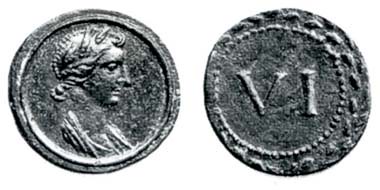
Spintriae could show quite "decent" motifs, too. Here one example from auction sale MMAG 81 (1995), 237, with a representation of the goddess Ceres, perhaps with the facial features of Livia.
What was the Romans' opinion on that? What purpose did these tokens really served? The pieces' reverse can give us a little hint. They show numbers from 1 to 16. The single numbers can't be connected to a particular motif. On the contrary, on close inspection one discovers also very different images of which some were made with the same dies than the so-called spintriae: the portrait of the emperor Augustus with his radiate crown for example, the portrait of Livia and the double portrait of Augustus' grandsons that the emperor had adopted, Victoria, a temple, the Capricorn.
These images can't be connected with brothels, not by any stretch of the imagination. The spintriae and the tokens with the portrait of Augustus are dated to the period of Tiberius although some later objects made of bone exist, round or angular shaped, showing numbers on the obverse and Christian symbols on the reverse. Obviously then, the most important thing about these tokens in general wasn't the "obverse" with their changing motifs but the "reverse" constantly showing numbers.
We, too, know objects whose representation can vary but whose value remain the same. I am referring to playing cards. The spintriae may well have had a similar function - as tokens in a game whose rules are unknown to us.
In early Imperial Rome, the act wasn't declared a taboo. Although Augustus went to great lengths to restore the old customs of the forefathers, he failed - even in his own family. Hence, these images were part of everyday life, also suitable to decorate objects of utility such as tokens of a game, the wall of a villa or oil lamps. Private companies manufactured these tokens and distributed them - as they later did with the contorniates.
And the moral of the story is? Nothing is as dirty as what the viewer's dirty imagination turns it into.
To read the complete article, see: Honni soit qui mal y pense or What exactly was the spintriae's function? (www.coinsweekly.com/en/Archive/8?&id=9&type=a)
NOTES FROM E-SYLUM READERS: JANUARY 29, 2012
John Pinches Advertising Medal
Harry Waterson forwarded this eBay item. Noting:
I don't know many numismatic businesses that could blow its own horn so attractively.
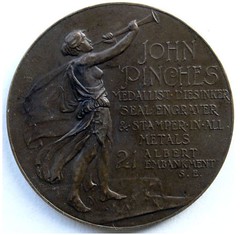
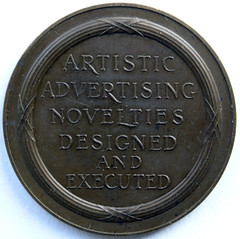
To view the complete ebay item, see: John Pinches advertising self promotional art medal medallion London C19th VGC
Colonial Jack's Long Walk
Last week I wrote about "the 9,000-mile walk of John Albert Krohn, who walked all around the perimeter of the United States in 1908, distributing tokens along the way."
Arthur Shippee writes:
Given the token and date begun, I imagine he started westwards, eh? He'd have to, right? Just think of the weather if he'd gone the other direction.
Mike Metras writes:
That's an interesting medal Krohn had - seems he sold it to make money for his walk. I found a couple others medals of his and interesting histories with a quick search on Google. Seems he was also known as Coronal Jack. From some of the pages I saw, I guess we aren't the only ones to have crossed the US on foot. We did meet one other cross-country walker. Jim Bragg a retired farmer from northern Wisconsin walked across the US in four years, three months at a time.
On Wealth and Theft
Alan V. Weinberg writes:
Regarding the suggestion that only a wealthy man can be trusted not to steal from a numismatic institution: What about the prominent surgeon who was a Fellow at the American Numismatic Society and stole millions in ancients, overdates, etc from their vault shelves to which he had unimpeded access? He was expelled from the ANS and successfully criminally prosecuted.
There is scarcely a collector of any wealth range - poor or fabulously wealthy - who hasn't from time to time had access to something numismatic he /she coveted and momentarily contemplated a theft. It is then that their upbringing, their love of the hobby, their respect for other numismatists and the thought that they'd have to forever possess the stolen item(s) in utter secrecy that kicks in and shakes the thought out of their mind.
For once the prized item is possessed, there is no joy left other than to exhibit it to other numismatists from time to time and to relive the enjoyment of initially acquiring it as reflected in their viewers' reaction and admiration. And you cannot do that if the item is stolen.
To read the earlier E-Sylum article, see: THOUGHTS ON THE ANA MUSEUM THEFT (www.coinbooks.org/esylum_v15n04a13.html)
Pride of Publication
NBS webmaster Bruce Perdue writes:
In response to the typesetting article I'd like to add that while I have never set type, I am engaged in an 'almost" the modern day equivalent when I code a web page, in that when I look at the end result I can take pride in my work and see the results immediately and know that it is available on the internet to the world.
I'd also like to remind the E-Sylum readership that I am currently running for Vice President of Central States Numismatic Society and would appreciate their support.
Notes from Joe Boling
Here are notes on from Joe Boling on multiple topics from last week's issue:
New Subscriber Jeff Bercovitz : It's Jeff Bercovitz - he uses the abbreviated form (bercovi) in his email address.
Ingrid Smith and the U.S. Mint Dies: What happened to Ingrid Smith is an example of the saying that "no good deed goes unpunished". When the US Mint needed assistance from the Royal Canadian Mint in finishing some dies back in the early '80s (Susie Bs, as I recall), a shipment of said dies was purloined. When offered to Ingrid in her role as a dealer, she bought them to return to the US Mint. As I understand it, not only did she not get recompense for her considerable expense, she was blacklisted from entering the US thereafter. What a travesty.
Roman brothel token and Treasure Trove Laws: Regarding Bob Dix and his earlier-than-recently-found Roman brothel token - he is quoted as saying that he is "eagerly waiting to hear what the experts say." More than likely, the first thing they will say is that he violated the treasure trove acts in failing to offer his piece to the local coroner, and they will give him no end of grief about it. What, me cynical?
Berbice and Demerara : Berbice and Demerara are both names of rivers in British Guiana.
Facebook Currency : O, goody! Facebook credits! I'll wager some hacker has already counterfeited them. Of course I'm cynical!
To read the earlier E-Sylum issue, see: Volume 15, Number 04, January 22, 2012 (www.coinbooks.org/club_nbs_esylum_v15n04.html)
QUERY: HOW LONG DOES PERMISSION TO REPRINT LAST?
Dick Hanscom writes:
I have a project that I have been thinking about/working of for 15+ years. No sense hurrying things. This project requires reprinting articles from various sources. I have received permission to do so. My question is-
How long is that permission valid? Some of these "permissions" are 10+ years old. Perhaps readers can enlighten me.
QUERY: ISSUES OF 'THE NUMISMATIC JOURNAL'
Bryce Brown writes:
Regarding the small monthly publication "The Numismatic Journal", produced by L.S. Drowne of North Adams, MA. How many issues were produced in total? I just ran across issues 1 through 5, produced August through December 1877. It was stated to be at least a 12-issue publication to subscribers. Are all these (or more) known?
Can anyone provide more information on this little periodical? -Editor
QUERY: CAL WILSON'S NUMISMATIC REPOSITORY
Joe Foster writes:
Maybe one of our readers could help me. I am trying to locate Cal Wilson's last Numismatic Repository issue, Vol 5 nos. 5 and 6, published electronically in October. 2001. Steven Pradier had a website that published Cal's Repository, but it is not now active.
QUERY: SWEDISH MINT MUSEUM 1815 HALF EAGLE
David Stone writes:
I am researching an article on the 1815 half eagle and hope your readers can help me with a question. Joseph Mickley reported seeing an example of this rare coin in the Swedish Mint Museum circa 1871, but I cannot find anyone that has actually seen the coin since that time. Can any E-Sylum reader confirm if the coin is still there? Thanks for any help you can give me.
QUERY: CIVIL WAR SCRIP TRAIN VIGNETTE USAGE SOUGHT
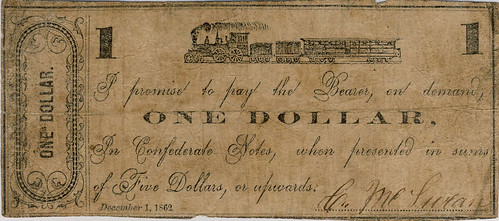
Dennis Schafluetzel writes:
Hugh Shull showed me this piece of Civil War scrip which does not have a city or state of issue. His guess was it was from Georgia or Tennessee. The distinctive vignette has three wheels under the first two cars and six wheels under the last car. Most scrip has only two or four wheels.
I looked through all of the scrip in the book I am preparing of Tennessee bank notes and scrip (600+ pieces) and found 3 notes with this type of train vignette all from the same city. I looked through the by David Marsh Georgia obsolete site ( www.davidmarsh.com ) but could not find any similar vignettes. Before I declare it from Tennessee would like to ask E-Sylum readers if they recognize this vignette from another city/state. Please let me know the city/state if you find another piece of scrip with this type of vignette.
I've always enjoyed Civil War scrip notes, especially those payable in Confederate Notes - one worthless piece of paper backed by another ultimately worthless piece of paper. . -Editor
QUERY: PEDIGREE OF THE DECADRACHM OF AKRAGAS
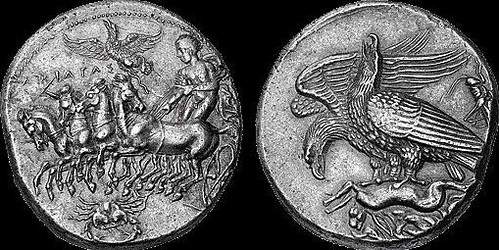
Howard Cohen writes:
I could not believe law enforcement officials removed the "Decadrachm of Akragas" from the January auction sale held by the Classical Numismatic Group. This coin has been in various collections in the United States, Switzerland and the UK. since the 1960's. On what basis after nearly 50 years would warrant the seizure of this famous Greek coin?
The articles do not mention how Dr. Arnold Peter Weiss acquired this specimen. It most definitely was by private treaty, as were a number of the 19 coins from his collection, offered as "Masterpieces of Ancient Greek Coinage" and presented in a superb catalogue.
The two auction firms involved in the sale state the coins are in the U.S. legally, and left Europe legally. Dr. Weiss is a world famous hand surgeon, and a dedicated collector.
The other coin in question that was seized "Tetrardrachm of Katane" was found last year in Italy. Recently there have been many complaints from Italy, Greece, and Turkey that various artifacts, including coins have left their country illegally. They are trying to have our government pass some laws pertaining to the removing of all these artifacts.
Dr. Weiss is a Trustee of the American Numismatic Society, and I'm sure his acquiring of his coins were all legal purchases. I'd like to know if any of our subscribers know about the various collections, since the 60's that contained this famous Greek Coin.
From Coins Weekly:
The affair got under way - according to the deponent - due to information of the Italian Carabinieri Tutela Patrimonio Culturale. John Freck said that a "confidential informant" had recorded a conversation, in which Peter Weiss said about the tetradrachm of Catane: "there's no paperwork, I know this is a fresh coin, this was dug up a few years ago ... This was dug up two years ago. I know where this came from." The deponent claimed that Peter Weiss himself had informed him that he purchased the coin in 2010 for $ 250,000 in order to sell it for approximately $ 350,000.
To read the Coin Week article, see: Seizure and Detention at the New York International (www.coinsweekly.com/en/News/4?&id=968)
To read the CoinWorld article, see: Officials seize two ancient coins at NYINC (www.coinworld.com/articles/officials-seize-two-ancient-coins-at-nyinc/)
THE BOOK BAZARRE
MORE ON MEDAL MAKER LORIOLI FRATELLI

I did business with Lorioli from 1961 to 1967, and visited with them twice over various projects that I commissioned, i.e. an unfinished Presidential series of 50mm medallions, and another completed project for my father's business in Winnipeg, Canada depicting a provincial map/flower series of medallions in honor of Canada's centenary in 1967.
Having an extensive knowledge at the time in various metal stamping production processes in that trade and another unrelated business trade thatI operated as well, never did I see any sign of pressure casting, or die casting machinery of any type.
Lorioli had a very large array of stamping presses, ranging from high speed coin presses for 32mm and under planchets and strips, to very high striking capacity in excess of 500 tons for striking and raising images on their 100mm and large projects, such as the Pius X11/Holy Year 100mm pieces, with the most incredible relief, and the JFK 100mm 1964 commemorative piece done in house and sculpted by Constantio Affer (who did some of our work), a gentle, and intense artist with whom we had the pleasure of being shown personally, his work right from original, to plasters, to the pantograph master die cutting process.
Happily, I still retain a few each of the above.
As the faking, or less politely put, counterfeiting, it would be insulting to Lorioli in the least, as to this day, still working with makers in precision die casting commissions of high grade pressure casting and "lost wax" investment casting, and although a number of firms have sent us their best presentation pieces over the years, there is no way outside of use of time honored quality stamping presses with specially hardened tool steel dies that one could ever achieve the artistic integrity and detail that firms like Lorioli have excelled in for centuries.
To read the earlier E-Sylum article, see: ITALIAN MAKER OF PAPAL AND RELIGIOUS MEDALS: LORIOLI FRATELLI (www.coinbooks.org/esylum_v12n46a12.html)
HARVEY STACK: THOUGHTS OF AN OLDTIME AUCTIONEER
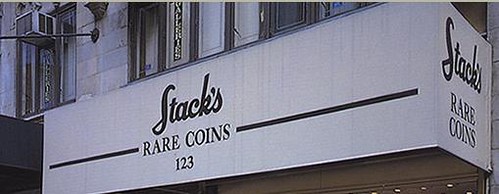
Alan Weinberg and I thought E-Sylum readers might enjoy this reminiscence of our experience at the many Stack's sales over the decades in a pre-computer era. Nowadays, auction rooms are a wholly different experience with sparse physical audience attendance, and overwhelming action via the phone and Internet. Something is missing in the auction room atmosphere, in the thrill of attending and participating in such auctions and it is not replaced by sitting at a computer at home and monitoring it "live ".
We all remember the 20 or so sessions of the John J. Ford sales (2003-2007) that the "old" Stack's in NYC conducted with every seat taken and many bidders standing along the walls. There was pure electricity in the audience, a buzz in the air , and considerable applause. Along with much humor expressed at the podium. The Ford sales were perhaps one of the last such "oldtime" experiences , except perhaps the Stack's Baltimore Norweb sale in 2006.
There's nothing like "being there" at a substantial auction.
As an "old time auctioneer", who was fortunate to have the opportunity to conduct well over 700 sales, which had several thousand sessions, I too miss the interaction that occurred during the sales.
I loved to sell to the active bidders, try to encourage them to keep up the bidding, trying to control the room for those who only knew to be disruptive (see below) , standing for hours at a time conducting the sale, using mail bids as my starters, and taking bids from all parts of the room and the phone "bank", watching how some tried to hide their bidding , or whether they were bidding or stretching, others talking too loudly to try to create a distraction so THEY could capture a coin, seeing the excitement of acquisition, at times the audience applause, the disappointment of the underbidder (who at times stormed out of the auction room), hoping the mike doesn't die, hoping the food arrived on time and hot, and hoping that we were satisfying all who came, and just enjoying being with the collectors in the room is something that the Internet cannot replace.
It may help more to feel that they are present, but the total atmosphere of the room, with bidders' enthusiasm evident, is just not possible by wire.
As you [Alan] said "YOU HAD TO BE THERE TO APPRECIATE AND RELISH THE EXPERIENCE ". And as an auctioneer I saw it all happening - except when Don Partrick turned his chair around, back to the auction podium, and facing the audience to monitor his competition FIRST HAND at the later Ford sales .
I REALLY MISS THOSE DAYS !!
Alan and I fondly remember a Stack's auction session in the early 1960's at the old Park Sheraton Hotel up the street from Stack's on 57th Street. During the sale a particularly appealing rare Pioneer gold coin came up. John Ford was bidding against Max Kaplan in a fierce contest to the point where both deep- voiced, cigar-waving "gentlemen" stood up at opposite sides of the room and yelled at each other to back off, each feeling they alone were entitled to buy the coin. Someone had to physically intervene and convince them to sit down and stop shouting at each other and disrupting the auction ( many of us remember Ford's fist fight with collector Donald Miller years earlier ) .
On another occasion during a Bowers & Merena 1983-84 Virgil Brand estate auction, we recall John Ford avidly bidding on an 1850 San Francisco gold hand-engraved and hand-constructed unique gold medal. Ford was "annoyed" by the floor competition and yelled out in his well-remembered booming and intimidating deep voice : "Whaddya want this handmade cockamamie thing for?" ( directed at his unknown competition ) .
Well, that may have worked and Ford got it for $9,900. That medal almost 3 decades later resold in one of the final Stack's Ford auctions for $316,250, a record at that time for an American medal - later well surpassed by Stack's Nov 2006 Norweb Baltimore auction of the gold 1889 George Washington St-Gaudens medal at $391,000 and in the same Baltimore sale the Zachary Taylor gold Congressional medal for $460,000 in two fierce floor/phone bidder battles in auction rooms almost as crowded (but not quite) as the Ford sales.
These are the fond, vivid memories that can't be replaced or replicated any longer. THAT WAS WORK AND FUN AT THE SAME TIME.
Thanks for jogging my memory. It was Great !!!
THE QUOIN CLUB
Charlie Davis writes:
David Klinger's notes on the term quoin caused me to dust off a silver vase that was given to my great grandfather who owned a department store on Chicago's State Street. In the early teens, the store merged with A. M. Rothschild and in 1915, the store was an awarded a prize by the Quoin Club - The National Periodical Association "for Window Display of Nationally Advertized Merchandise."
In a leap of translation, I can see the French "coin," meaning the architecturally attractive corners of a building, extending to the windows, but I have never been able to find anything about this organization. It must have been somewhat respectable in its day as the vase weighs 31 oz sterling (Good thing that in 1980 I thought it was silver plate!)
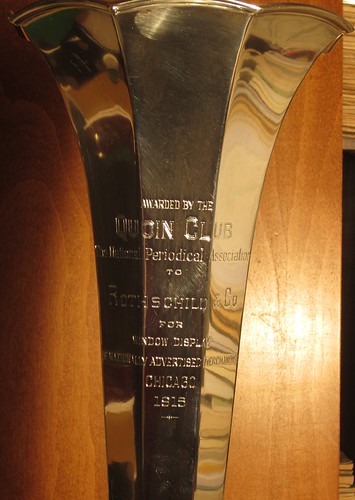
To read the earlier E-Sylum article, see: VOCABULARY WORD: QUOIN (www.coinbooks.org/esylum_v15n04a11.html)
CHICAGO NEWSPAPER ARTICLE HIGHLIGHTS HARLAN BERK
Dick Johnson writes:
There's a nice article on Harlan Berk in the Chicago Sun-Times this week. But it's far too short. I wanted more.
Question: What does a newspaper writer call a coin album?
Answer: Cardboard book.
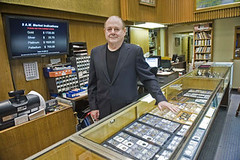 Treasure is a relative thing, depending entirely upon the person seeking it.
Treasure is a relative thing, depending entirely upon the person seeking it.
Which is why at Harlan J. Berk Ltd., you can walk in to the small shop at 31 N. Clark and walk out a delighted 7-year-old clutching a worn Indian head penny fished out of a bowl of old coins for $1.50, the start of a lifetime of collecting, or a satisfied 60-year-old clutching a gold stater of Alexander the Great you have searched for all your life, a steal at $5,000.
I was drawn to Berk because the kid who used to save wheaties - Lincoln pennies minted before 1959 with wheat stalks on the back - still lurks within, and I was charmed that, while you can't find a toy store in the Loop, there is still a place selling cardboard books to press your Mercury dimes into.
But, spending a morning with the dapper and knowledgeable Berk, I very quickly realized that the extraordinary aspect of the place isn't as an oasis of nostalgia but as a treasure house of ancient wonders - Berk sells coins, yes, but also antiquities: Roman marble, Corinthian helmets. Each has a tale.
"This is Minoan," Berk says in front of a large, sand-colored casket with the tangled cartoon of a sea beast on it. "A cuttlefish, or squid. When the Minoan society was destroyed, Greeks came in a thousand years later, saw homes without roofs and [pictures of] bulls inside - the Minoans did bull leaping - so the Greeks said, 'Oh, this must be a labyrinth.' The whole thing of the Labyrinth and the Minotaur was a misinterpretation. This is better than the one in the Met."
We're standing in the warren of rooms behind the store, cluttered with centuries-old maps, Egyptian funereal objects, Neolithic burial statuary, oddly smiling figures, plus 17,000 books with titles such as The Red Figured Vases of Apulia - reference works, not for sale, though interested members of the public are allowed to consult them.
"It's hard to keep the place in order," Berk says.
To read more in the complete article, see: Coin dealer wise to world treasure (www.suntimes.com/news/steinberg/10270689-452/coin-dealer-wise-to-world-treasure.html)
THE NEW ORLEANS MINT TREASURE
Regarding Mark Van Winkle's report on a research excursion to the National Archives in Fort Worth, TX, Tom Hoke in Kemah, Texas writes:
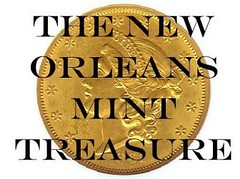 I have used the National Archives in Ft. Worth several times. The data displayed in the gold book shows why the mintage records for the $20 1861-O gold double-eagle is incorrect. The data does not end in 1860 as you stated. It ends with January 16,1861....which is the short period before the State of Louisiana took over.
I have used the National Archives in Ft. Worth several times. The data displayed in the gold book shows why the mintage records for the $20 1861-O gold double-eagle is incorrect. The data does not end in 1860 as you stated. It ends with January 16,1861....which is the short period before the State of Louisiana took over.
Coin books reflect the wrong mintage records for the gold and silver produced in this one month period. You might be interested in my November 2011 article in The Numismatist which shows mintage records based on a Treasury Department audit in December, 1871 which covered the gold and silver produced at the New Orleans mint from 1838 through January, 1861. You might be interested in my story: "The New Orleans Mint Treasure" free at: www.tomhoke.com
Much of the excellent data from the records in Ft. Worth is cited in my story.
The inventory of gold in the New Orleans Mint on January 30, 1861 does not reflect the minted coins which were legally removed from the mint in the many January exchanges of British sovereigns for the gold in the mint, except as a notation most of the gold had already been credited to individuals who had already removed it from the mint and dumped it into Citizens Bank.
The silver half-dollars also have mintage numbers which show there was a "problem."
I have a query in to the Treasury Department...to see if they stand behind their December, 1871 audit....or the mintage figures in our coin books. Probably I will get a "diplomatic" nothing....reply.
All the best....and yes, the New Orleans Mint records in Ft. Worth are being used!
To read the earlier E-Sylum article, see: NEW ORLEANS MINT RECORDS AT FORT WORTH NATIONAL ARCHIVES (www.coinbooks.org/esylum_v14n05a13.html)
THE BOOK BAZARRE
DEALERS REBEL OVER ROYAL MINT'S COMMEMORATIVE FLOOD
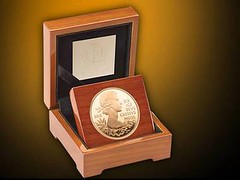 The Royal Mint is being accused of exploiting the general public with overpriced commemorative coins that have minimal investment value.
The Royal Mint is being accused of exploiting the general public with overpriced commemorative coins that have minimal investment value.
After 38 years as a Royal Mint agent, a leading numismatic dealer with 57 years in the business, is now refusing to trade in any more of its coins because he believes the market has been devalued by the vast numbers of issues and exorbitant prices.
Richard Lobel - the UK's biggest dealer in the secondary market for Royal Mint coins - condemns what he sees as the exploitation of people who pay up to four-figure sums for what they assume are valuable keepsakes.
He said that coins celebrating the 2012 Olympics and the Queen's Diamond Jubilee are among issues that are worth far less than the prices paid. The resale value of most non-gold coins is under 50 per cent of the original price.
Mr Lobel, managing director of Coincraft, said: "I'm tired of how many people's hearts we've had to break."
Until a few years ago, the Royal Mint issued commemorative coins for exceptional events. Now, there are dozens of issues - 68 for the Olympics alone. They include a gold £5 coin now selling on the Royal Mint website for £2,880, for which the owner might get £1,400 at most. A dealer would resell it for £1,500 to £1,600, Mr Lobel said.
Other experts echoed his criticisms. Seth Freeman of Baldwin's, numismatic dealers since 1872, said: "Once somebody's bought a set from the Royal Mint, it's worth about a quarter to a third of what you paid for it ... and I've never known anyone to get their money back, even in these days of high gold prices."
Experts believe that the Royal Mint issues too many coins, in too many different metals, while repeatedly raising prices. Mr Lobel said: "In the last four or five months, they've started charging almost £100 for a silver-proof crown. We saw it go to £49.50 and we were shocked. Then it went to £55 and we were stunned. I don't know what word we used for £99.50."
There is no real investment in older issues, he said, citing coins marking the wedding of the Prince of Wales and Lady Diana Spencer in 1981, sold then for around £39: "Today, we'd sell them for the same price." Those done for a Diana and Prince Charles overseas tour fared even worse, he added: "We melt those."
Peter Jackson, another numismatist dealer, said: "With the economic situation, people are tending to look upon coins as an investment. A lot of people don't really know what they're buying ... I think there'll be a lot of tears shed in a few years' time when people realise. The Royal Mint ... is trading on their name to such an extent that they're pumping out all sorts of things."
But Shane Bissett, the Royal Mint's director of Commemorative Coin, argues that with sales of £150m last year, demand is strong and prices reflect the craftsmanship involved.
On being asked about the disappointment of owners about resale values, he said: "Commemorative coins are not sold as investments. They're sold to celebrate commemorative events."
To read the complete article, see:
Mint accused of making a mint from overpriced souvenir coins
(www.independent.co.uk/news/uk/home-news/mint-accused
-of-making-a-mint-from-overpriced-souvenir-coins-6294131.html)
ZAMBIA TO REVALUE CURRENCY AND INTRODUCE COINS
 The Minister of Finance and National Planning Mr. Alexander Chikwanda announced on Monday that Government was going to rebase the Kwacha by slashing off three zeros from our currency and introduce coins for lower value denominations instead of notes. The largest note therefore will be K50 from the current K50, 000 while the lowest will be K1 from K1, 000.
The Minister of Finance and National Planning Mr. Alexander Chikwanda announced on Monday that Government was going to rebase the Kwacha by slashing off three zeros from our currency and introduce coins for lower value denominations instead of notes. The largest note therefore will be K50 from the current K50, 000 while the lowest will be K1 from K1, 000.
He added that the new currency will be introduced in the next six months during which period the old currency will be withdrawn. The question that begs an answer is what is the effect of rebasing the Kwacha on the economy and the ordinary Zambians in general?
Rebasing is mainly done to make commercial transactions easier and reduce the cost of transaction by transacting in fewer notes. The exercise is also done to enhance people's confidence in the currency and stabilize its fluctuations.
To read the complete article, see:
WHAT DOES REBASING OF KWACHA MEAN TO THE POOR
(www.ukzambians.co.uk/home/2012/01/26/what-does
-rebasing-of-kwacha-mean-to-the-poor/)
To read a related article, see:
Cabinet approves Kwacha rebasing
(www.ukzambians.co.uk/home/2012/01/23/
cabinet-approves-kwacha-rebasing/)
BANKNOTE MATH QUESTIONED
About the accompanying BBC News article, Philip Mernick writes:
This is a long running fraud trial and the reports say the prosecutor has made some interesting and in my opinion incorrect claims. He says 148.8 million Turkish Lira in 100 Lira notes would weigh 135,000 kilos and be 300 times the height of Nelson's Column.
148.8 million Lira would be 1.48 million 100 Lira notes. For 1.48 million notes to weigh 135,000 kilos each would have to weigh 90 gm or approximately 4 oz. Equally for 1.48 million notes to be as tall as 300 Nelson's Column (300 x 51.6 metres) each note would have to be 10 cm thick. I think somebody has miscalculated but nobody seems to have challenged the claims!
From the article:
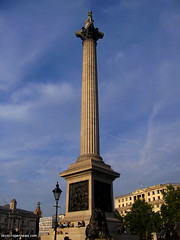 Businessman Asil Nadir would have needed banknotes 300 times the height of Nelson's Column to balance the books of his empire, the Old Bailey hears.
Businessman Asil Nadir would have needed banknotes 300 times the height of Nelson's Column to balance the books of his empire, the Old Bailey hears.
He has said when pounds were taken out in London, equivalent amounts in Turkish lire were placed in a subsidiary firm in northern Cyprus.
Philip Shears, QC, prosecuting, said the claims were "not credible".
Mr Nadir, who is accused of stealing nearly £150m from his Polly Peck empire, denies all the charges.
To read the complete article, see: Nadir 'needed 135 tonnes of cash', a court hears (www.bbc.co.uk/news/uk-16757185)
RUSSIAN LOCAL CURRENCIES OF THE 1990S
P.K. Saha forwarded links to two articles on Russian community currency, commenting,:
Russian communities issued local currency in 1990s. Should they be not catalogued/ recognised ?
A major problem in both the USSR and the Russian Federation has been the shortage of cash, the result of government policies which keep the monetarization of the economy "five to ten times less than in developed economies," a situation that reached its apogee in the years immediately after the collapse of the Soviet Union.
One consequence of that decline in the 1990s when the rate of monetarization of the economy fell to 15 percent, the Tolkovatel blog points out today was the appearance of self-minted currency in 750 republics and cities of the Russian Federation as well as at about 25,000 enterprises
In a detailed post richly illustrated with pictures of some of these notes and coins, the blog explains that the appearance of such currencies, which took the place of the lack of state-sanctioned cash, had its roots in Soviet times and was exacerbated by the specific conditions of Boris Yeltsin's rule.
To read the complete article, see: 750 Republic and Local Governments in Russia Issued Their Own Currencies in the 1990s (www.eesti.ca/?op=article&articleid=34913)

After the Revolution in the country are always shortages of money, were forced to overcome by printing banknotes surrogate. 1920 - the flowering of ersatz money. Their printed cities, factories, communities and institutions. Money substitutes were banned only in 1935, and only in the territory of the RSFSR decree of the CPC. And in Central Asia, for example, local "economic entities" coupons were printed and were circulated until 1941.
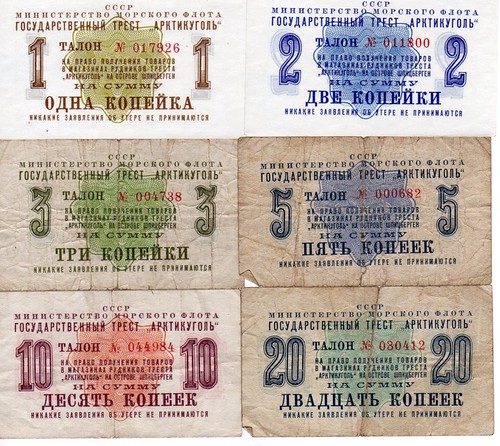
It is impossible to imagine any developed nation in the world where would parallel circulation of several kinds of legal money. This was observed in the occupied territories: for example, in the occupied Soviet territories in Germany 1941-44 legal tender were several kinds of money - Reichsmark, Soviet money specially printed for Ukraine karbovanetses, imperial gold coins. Perhaps, but still defeated Weimar Germany differed in the same (brand of various cities and lands in the 1920s).
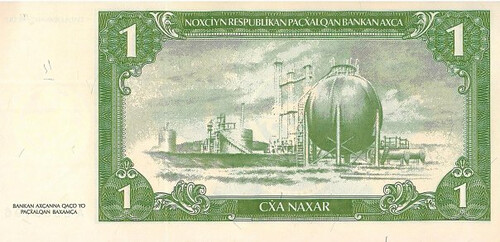

To read the complete article, see: Libertarian paradise ersatz money Soviet Union and Russia (ttolk.ru/?p=9273)
COIN SHORTAGE IN INDIA PROMPTS SPURS PRIVATE MINTERS
Fed up by the constant shortage and increasing black-marketing of coins, wholesale traders in South Mumbai have minted their own coins and are using them as currency. So far 50,000 coins of Re1 and Rs2 denominations have been minted and are being distributed in the wholesale markets in Bhendi Bazaar and Masjid Bunder.
The coins, made by the Mandvi-Koliwad association, were put in circulation in the first week of January. "A metal cast was made for one rupee and two rupee coins. Coins worth Rs50,000 have been made in the first batch; more will be made depending on the response," said Dinesh Shah, a grocery store owner and member of the association.
"We had no other option. For the past one year, shortage of coins has troubled us. Earlier, coins were easily available through the Reserve Bank of India outlet, but that too has stopped now."
Rampant black-marketing, because of the shortage, is another troubling aspect. "The situation is so bad that we have to pay a heavy premium on the coins," said Abdul Sattar, a bakery owner.
For one rupee coins worth Rs100 one has to pay Rs114, while for two rupee coins worth Rs100 one has to pay Rs115. For five rupee coins worth Rs100 one has to pay Rs118. "These rates keep changing. During festivals, the premium goes as high as Rs125 for coins worth Rs100," said a trader.
So far, the coins have been put into circulation in the wholesale market area of Masjid Bunder and Bhendi Bazaar. "Right now, only regular traders are using the coins so that the circulation remains within the market," said another trader.
To read the complete article, see: Mumbai traders mint coins to beat shortage (www.dnaindia.com/mumbai/report_mumbai-traders-mint-coins-to-beat-shortage_1641080)
MEDIEVAL COIN HOARD FOUND IN 1926 GOES ON DISPLAY
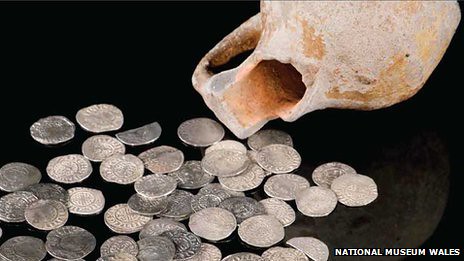
A hoard of medieval coins found in Wrexham in 1926 has gone on public display in the town for the first time.
The coins were unearthed in a jug in the garden of a house on Chester Road before eventually being donated to National Museum Wales.
The English short-cross pennies date from the reigns of Richard I (1189-99), John (1199-1216) and Henry III (1216-72).
Experts say they may have been buried for safekeeping in the 1240s.
Jonathon Gammond from Wrexham Museum said when the Wrexham Hoard was discovered the coins were shown to a handful of people, including a bank manager.
Over 40 years later the house was sold and the new owner found the jug and coins in a cupboard as the previous owner had left them, believing they were associated with the property.
The new owner declared them to the police and an inquest was held to determine their fate and, although they were returned to the home owner, he gifted them to the national museum.
To read the complete article, see: Wrexham Hoard goes on display at Wrexham Museum for first time (www.bbc.co.uk/news/uk-wales-north-east-wales-16689099)
FEATURED WEB SITE: ROCHESTER NUMISMATIC ASSOCIATION
This week's Featured Web Site is the Rochester Numismatic Association.Since 1912, the Rochester Numismatic Association has served the needs of coin collectors and dealers in Rochester and western New York. With over 110 members, the RNA meets twice monthly from September until June, in addition to sponsoring an annual Coin Show, banquet, and picnic. Meetings are now held the first and third Thursday of the month, starting at 8pm. Members typically show up around 7:30pm to socialize. The RNA is American Numismatic Association (ANA) Branch #2, and ANA Life Club #8. We are members of the American Numismatic Society, Canadian Numismatic Association, Empire State Numismatic Association, Token and Medal Society (TAMS), and the Rochester Museum and Science Center (RMSC).
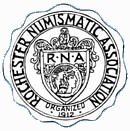
www.the-rna.com
